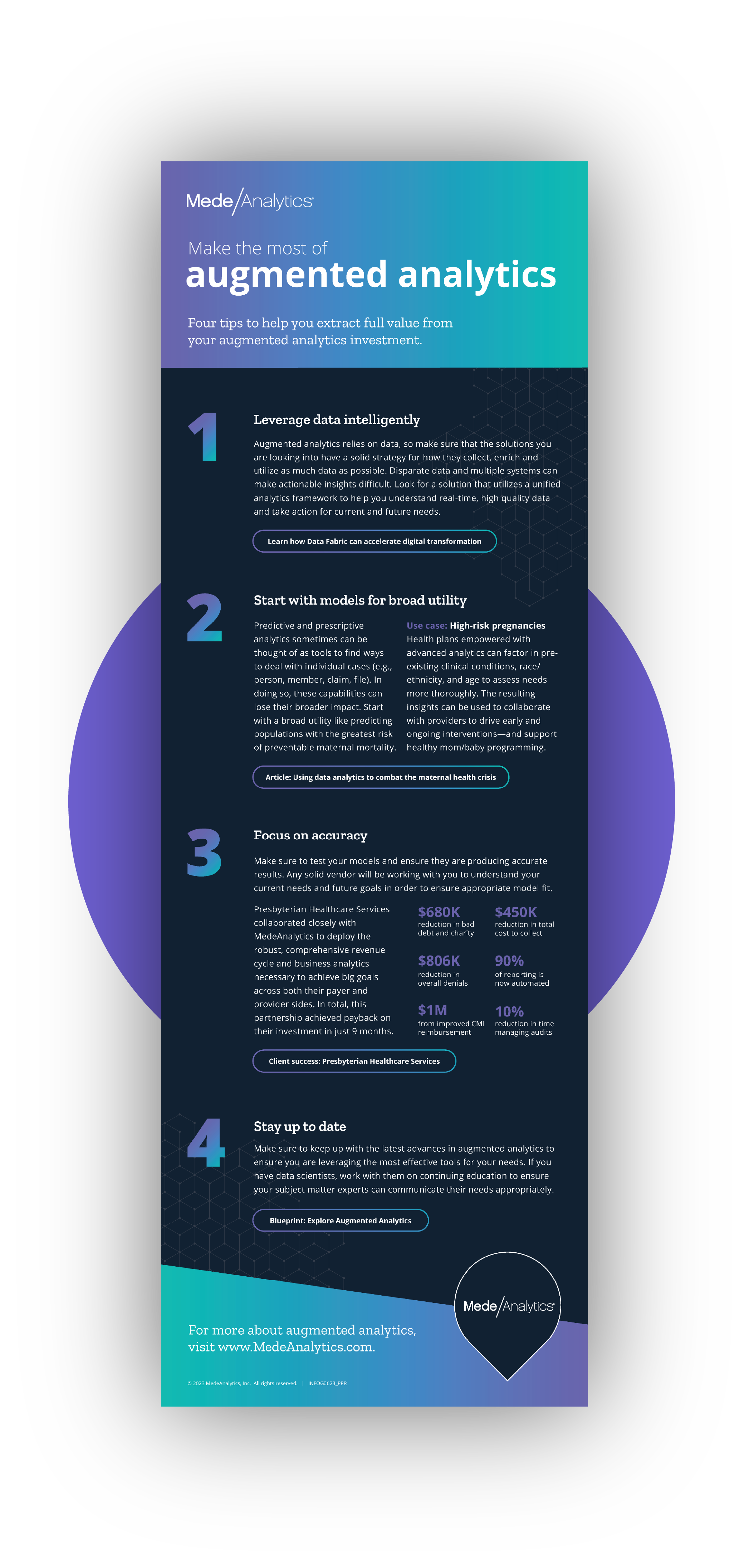Blueprint:
Providers and payers have become increasingly dependent on analytics to learn how they can deliver better outcomes for their patients or members and drive financial success for themselves. While we’ve seen incredible impact in some areas, the healthcare industry is still often seen as data rich and insights poor. But, there’s good news coming.
As technology continues to evolve and data grows more complex, many executives are championing augmented analytics as a way to revolutionize their processes and advance on clinical, operational and financial goals.
In this guide, we'll explore what augmented analytics is, the benefits it can bring to healthcare, and tips for leveraging it.
Augmented analytics applies technologies like machine learning and AI to support data preparation and analysis processes.
These capabilities help:
- front-end users operate more effectively in their day-to-day workflows
- data scientists deploy automations that save time and avoid human error
- managers track and transform performance with rules engines and alert triggers
- executives get a high-level view of complex trends with narratives and visualizations
Creating measurable impact by using augmented analytics is not only possible but necessary for organizations today.
A 2020 HIMSS report on technologies in healthcare found that 53% of AI platforms, tools, investments and resources are applied to clinical use cases, while 47% are applied to the back-office needs.
There are three key trends influencing this budding interest in and adoption of AI and augmented analytics across the enterprise.
Data is steadily growing
As information swells in volume and increases in complexity, manual processing is rapidly becoming archaic. Organizations need intelligent tools to sift through massive data sets, identify meaningful patterns, and make informed decisions.
Workforce shortages are increasing reliance on technology
In the face of record-high turnover and burnout, hospitals and health systems are turning to technological solutions. Augmented analytics can secure the quality and accuracy of data processing and decision-making, helping to reduce human error.
Automation is proving its worth
Health plans in particular are seeing the undeniable value in automation capabilities to deliver higher value and superior outcomes to their members. Automation allows payers and providers to easily perform risk-based segmentation and proactively deliver better care at a lower cost.
You may be thinking, ‘I’ve been hearing about advanced technologies for years, what has changed that deserves attention?’
Great question. Our answer is: outlook and expectations.
As an industry, we eagerly overestimated the short-term effects analytics and AI would have in healthcare—yet critically underestimated their long-term impact on the entire landscape.
As Lyle Berkowitz, MD, FACHP, FHIMSS noted at the 2022 Impact Summit, “This general sentiment has been applied across many industries for many innovations. It serves to remind us that though situations did not change overnight, the landscape is progressively shifting. We saw this happen with telehealth capabilities, and we will continue to see it as analytics and AI slowly transform care delivery. The question is merely, when will you adopt these technologies and how extensively will you use them?”
The business purpose of analytics is to take data from a hoard of numbers to a holistic plan for improving outcome.
The path from raw data to real action is comprised of four flavors of analytics:
- Number of admits
- Number of hospital-acquired infections
- Average length of stay
- Percentage of discharged patients utilizing home health
- Most diagnosed disease
- Why are certain patients not following their medication plans?
- For what reasons are patients being readmitted?
- What factors are affecting length of stay?
Predictive analytics can be used to predict a slew of critical metrics, including:
- claim denials
- future cash flows
- future PMPM
- patients that will eventually be high-cost claimants (HCC)
- avoidable emergency visits
While the use cases for predictive analytics are innumerable, we've identified two simple ways that healthcare providers can dip their toes in.
First, predictive analytics can be used to deliver better insights into the effectiveness of treatments and medications—based on both clinical data and socioeconomic factors.
Second, predictive analytics can be deployed to identify high-risk patients and proactively deliver meaningful interventions.
Unlike the other flavors of analytics, prescriptive analytics gives healthcare providers and payers methods of determining which processes must evolve to achieve improvement goals. This technique takes the forecasting and simulations data of predictive analytics and leverages rules and outcome-driven constraints to produce recommended decisions and important restrictions.
Prescriptive analytics holds much promise for helping healthcare organizations make better decisions in clinical settings, business operations, and the supply chain.
Where traditional analytics requires highly skilled subject matter experts to methodically organize and interpret data, augmented analytics takes massive amounts of information and surfaces valuable insights rapidly and accurately. Augmented analytics—in all its forms and flavors—promises many benefits to the healthcare industry.
Healthcare organizations have more data than they know what to do with, and it is captured from a variety of sources in a wide array of formats. Augmented analytics offers a simple way to sift through this data, organize it sensibly, and deliver actionable insights back to users.
Challenges in hiring and retaining staff extend far beyond clinical settings; health plans have also been struggling to fill roles. Augmented analytics offers the tools necessary to reduce manual effort while enhancing efficiency and output quality.
Augmented analytics can help providers to identify and diagnose patients more quickly and accurately, reducing the cost of care and improving patient outcomes. It can also help providers to better manage their practice and provide the best possible interventions.
Payers can deploy augmented analytics to examine the effectiveness of providers and interventions—and pinpoint ways to improve. Equipped with this knowledge, payers can construct a stronger network and devise better plan offerings to ultimately drive positive member outcomes.
Explore more on this topic from our experts:
Using analytics to integrate physical and mental health in whole-person healthcare
In the realm of healthcare, it is paramount to view physical and mental health as inherently interconnected aspects of wellbeing…
Read on...Is what you’re asking for really what you need? Tips for getting to the root of the problem—and finding the right solution
As a lifelong data enthusiast and healthcare leader, one of my primary objectives is to help transform a reservoir of…
Read on...Proactively predicting ER visit trends with augmented analytics to improve revenues, asset utilization and patient outcomes
Mission critical emergency departments (EDs) are the most valuable revenue generating asset for hospitals. While visits decreased during the pandemic,…
Read on...Will adopting a risk-based approach with augmented analytics support care gap closure?
A common challenge for healthcare systems is how to properly segment its patient populations based on risk profiles and co-morbidities. Doing this well ensures a high quality of care delivery and superior patient outcomes.
Read on...



